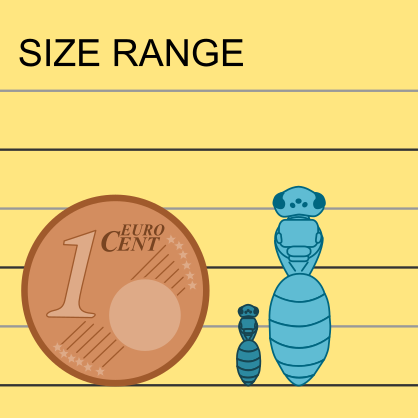Author: Latreille, 1802
|
Type species: Apis punctata Fabricius, 1775 = Apis albifrons Forster, 1771, by designation of Latreille, 1810.
Subgenera: Eupavlovskia Popov, 1955; Melecta s.str. Latreille, 1802; Paracrocisa Alfken, 1937. Synonyms: Symmorpha Illiger, 1807; Symmorpha Klug 1807; Bombomelecta Patton 1879. |
Clade: Anthophila
Family: Apidae Subfamily: Nomadinae Tribe: Melectini |
|
Distinctive traits
|
Pictures of distinctive traits
|
Morphologically close genera, and how to distinguish them:
Thyreus species have short and appressed hairs and a flat scutellum extending posteriorly in an emarginate crest.
- Melecta - Thyreus
Thyreus species have short and appressed hairs and a flat scutellum extending posteriorly in an emarginate crest.
General comments on Melecta species identification
Male identification requires extraction of the genitalia.
Male identification requires extraction of the genitalia.
Sorry, but the species identification tool is not yet available for Melecta.
Please check the reference(s) at the bottom of the page for traditional keys.
Please check the reference(s) at the bottom of the page for traditional keys.
List of the 26 Melecta species found in Europe (Ghisbain et al. 2023)
Melecta (Eupavlovskia) funeraria Smith, 1854
Melecta (Eupavlovskia) obscura Friese, 1895
Melecta (Melecta) aegyptiaca Radoszkowski, 1876
Melecta (Melecta) albifrons (Forster, 1771)
Melecta (Melecta) alcestis Lieftinck, 1980
Melecta (Melecta) amanda Lieftinck, 1980
Melecta (Melecta) baerii (Radoszkowski, 1865)
Melecta (Melecta) canariensis Lieftinck, 1958
Melecta (Melecta) caroli Lieftinck, 1958
Melecta (Melecta) curvispina Lieftinck, 1958
Melecta (Melecta) diacantha Eversmann, 1852
Melecta (Melecta) duodecimmaculata (Rossi, 1790)
Melecta (Melecta) eversmanni Radoszkowski, 1893
Melecta (Melecta) festiva Lieftinck, 1980
Melecta (Melecta) fulgida Lieftinck, 1980
Melecta (Melecta) gracilipes Lieftinck, 1980
Melecta (Melecta) grandis Lepeletier, 1841
Melecta (Melecta) guichardi Lieftinck, 1980
Melecta (Melecta) leucorhyncha Gribodo, 1893
Melecta (Melecta) luctuosa (Scopoli, 1770)
Melecta (Melecta) mundula Lieftinck, 1983
Melecta (Melecta) prophanta Lieftinck, 1980
Melecta (Melecta) rutenica Radoszkowski, 1893
Melecta (Melecta) tuberculata Lieftinck, 1980
Melecta (Melecta ) italica Radoszkowski, 1876
Melecta (Paracrocisa) guilochei Dusmet y Alonso, 1915
Melecta (Eupavlovskia) funeraria Smith, 1854
Melecta (Eupavlovskia) obscura Friese, 1895
Melecta (Melecta) aegyptiaca Radoszkowski, 1876
Melecta (Melecta) albifrons (Forster, 1771)
Melecta (Melecta) alcestis Lieftinck, 1980
Melecta (Melecta) amanda Lieftinck, 1980
Melecta (Melecta) baerii (Radoszkowski, 1865)
Melecta (Melecta) canariensis Lieftinck, 1958
Melecta (Melecta) caroli Lieftinck, 1958
Melecta (Melecta) curvispina Lieftinck, 1958
Melecta (Melecta) diacantha Eversmann, 1852
Melecta (Melecta) duodecimmaculata (Rossi, 1790)
Melecta (Melecta) eversmanni Radoszkowski, 1893
Melecta (Melecta) festiva Lieftinck, 1980
Melecta (Melecta) fulgida Lieftinck, 1980
Melecta (Melecta) gracilipes Lieftinck, 1980
Melecta (Melecta) grandis Lepeletier, 1841
Melecta (Melecta) guichardi Lieftinck, 1980
Melecta (Melecta) leucorhyncha Gribodo, 1893
Melecta (Melecta) luctuosa (Scopoli, 1770)
Melecta (Melecta) mundula Lieftinck, 1983
Melecta (Melecta) prophanta Lieftinck, 1980
Melecta (Melecta) rutenica Radoszkowski, 1893
Melecta (Melecta) tuberculata Lieftinck, 1980
Melecta (Melecta ) italica Radoszkowski, 1876
Melecta (Paracrocisa) guilochei Dusmet y Alonso, 1915
References with identification keys for some of the species:
- Lieftinck M.A. 1980. Prodrome to a monograph of the Palaearctic species of the genus Melecta Latreille 1802 (Hymenoptera, Anthophoridae). Tijdschrift voor Entomologie, 123(6): 129-349, 8 pls.
Online resources:
Atlas hymenoptera (Europe & Belgium)
BWARS (UK)
Discover Life (World)
WestPalBees (West Palearctic)
Atlas hymenoptera (Europe & Belgium)
BWARS (UK)
Discover Life (World)
WestPalBees (West Palearctic)
Page contributors:
You noticed a mistake? You have a suggestion to improve this page?
Don't keep it to yourself, contact us and become a contributor to IDmyBee!
References used to write this page:
- Adrien Perrard (Dec. 2023)
- Adrien Perrard (Dec. 2019)
You noticed a mistake? You have a suggestion to improve this page?
Don't keep it to yourself, contact us and become a contributor to IDmyBee!
References used to write this page:
- Ghisbain, G., Rosa, P., Bogusch, P., Flaminio, S., Le Divelec, R., Dorchin, A., Kasparek, M., Kuhlmann, M., Litman, J., Mignot, M., Müller, A., Praz, C., Radchenko, V.G., Rasmont, P., Risch, S., Roberts, S.P.M., Smit, J., Wood, T.J., Michez, D. & Reverte, S. (2023). The new annotated checklist of the wild bees of Europe (Hymenoptera: Anthophila). Zootaxa, 5327(1), 1-147.
- Michener, C.D. 2007. The Bees of the World, 2nd Edition. The John Hopkins University Press, Baltimore.
- Michez D., Rasmont P., Terzo, M., Vereecken, N. 2019. Abeilles d'Europes. Hymenoptères d'Europes, Volume 1. N.A.P. Editions.
- Nieto, A., Roberts, S. P., Kemp, J., Rasmont, P., Kuhlmann, M., García Criado, M., ... & Michez, D. 2014. European red list of bees. Luxembourg: Publication Office of the European Union, 98. (IUCN 2014)
- Rasmont, P., Devalez, Jelle, Pauly, A., Michez, D. & Radchenko, V.G. 2017. Addition to the checklist of IUCN European wild bees (Hymenoptera: Apoidea). Annales de la Société entomologique de France 53: 17-32.



